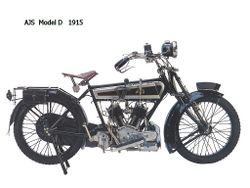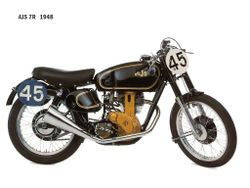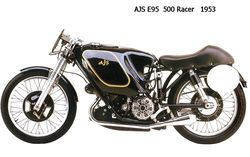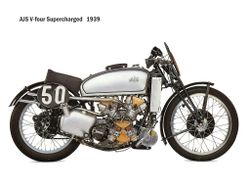Difference between revisions of "AJS"
| Line 18: | Line 18: | ||
Most of AJS's roadsters were less inspiring singles and parallel twins such as the Model 30, with its 600cc engine that had almost square dimensions giving it a smoother ride than comparable models. With peak power producing 33bhp the twin was capable of cruising at 70mph. Combined with predictable handling, this made for a relaxed comfortable bike suitable for traveling long distances. The Model 30 was also well-made, reliable, and economical, unfortunately such attributes were not enough to keep AJS in business. Poor sales led to '''AMC''' becoming part of '''[[Norton]]''' Villiers in 1967. Some '''AJS''' bikes were then continued incorporating Norton parts, but they were not successful and the factory ceased production shortly afterwards. | Most of AJS's roadsters were less inspiring singles and parallel twins such as the Model 30, with its 600cc engine that had almost square dimensions giving it a smoother ride than comparable models. With peak power producing 33bhp the twin was capable of cruising at 70mph. Combined with predictable handling, this made for a relaxed comfortable bike suitable for traveling long distances. The Model 30 was also well-made, reliable, and economical, unfortunately such attributes were not enough to keep AJS in business. Poor sales led to '''AMC''' becoming part of '''[[Norton]]''' Villiers in 1967. Some '''AJS''' bikes were then continued incorporating Norton parts, but they were not successful and the factory ceased production shortly afterwards. | ||
==Models== | |||
*[[AJS 7R|7R]] | |||
[[List of motorcycles from Great Britain]] | [[List of motorcycles from Great Britain]] | ||
Revision as of 18:22, 20 January 2011
AJS was founded by Albert John Stevens (hence the name) in Wolverhampton around 1900. AJS won the Junior TT in 1914, but their greatest racing accomplishments came later, memorably when Les Graham won the first ever 500cc world championship on the Porcupine twin in 1949. By 1931 AJS held 117 motorcycle world records.
Merger with Matchless
In 1931 AJS was taken over by Matchless of London. The merged firms formed Associated Motor Cycles (AMC) in 1938, but the AJS and Matchless marquees were retained to retain their owner loyalty. This resulted in the bikes having cases of split personalities in which the Matchless version was the same bike differing only in paint color, badges, and exhaust systems. When civilian production resumed during 1946 there was little to distinguish between the Matchless G3L and G80 models and the AJS 16 and 18 variants other than the position of the magneto and badge on the tank.
With an emphasis being placed on production, the company concentrated their efforts on the singles which were largely the same as the wartime G3L except for color and the displacement of the larger models. However, their experience with hydraulic suspension gained during the war years resulted in the manufacture for the 1949 domestic market models ( there is some evidence of machines being built with a sprung frame from 1947 onwards for export) of a pivoted fork frame which was used on both the singles and the recently introduced twin. The new frame, equipped with slender damper units of AMC's own design, was superior to their rivals plunger based systems both in terms of road holding and comfort. The next major revision to the singles range occurred during 1951 when the original suspension units were replaced with the distinctive "jampot" units.
Detail revisions occurred over the next four years, a new Burman gearbox had been introduced during 1952 and auto advance had been added during 1954 together with a full width front hub, which was revised for 1955 and joined by a matching rear one. For 1956 a new frame was introduced with a restyled, long thin oil tank and matching toolbox which also housed the battery resulting in what is arguably the best looking of the "heavyweight" singles family and the only year that the full width alloy hubs, Jampots and long toil tank/toolbox coincided.
The most popular AJS racer was the single cylinder 350cc 7R, which was commonly known has "Boy Racer". It was first introduced in 1948, the 7R was hugely successful was later enlarged to 500cc with the Matchless G50.
Model 30
Most of AJS's roadsters were less inspiring singles and parallel twins such as the Model 30, with its 600cc engine that had almost square dimensions giving it a smoother ride than comparable models. With peak power producing 33bhp the twin was capable of cruising at 70mph. Combined with predictable handling, this made for a relaxed comfortable bike suitable for traveling long distances. The Model 30 was also well-made, reliable, and economical, unfortunately such attributes were not enough to keep AJS in business. Poor sales led to AMC becoming part of Norton Villiers in 1967. Some AJS bikes were then continued incorporating Norton parts, but they were not successful and the factory ceased production shortly afterwards.



